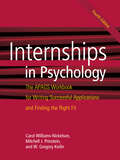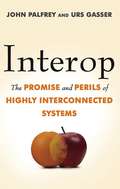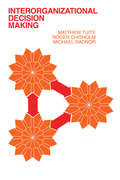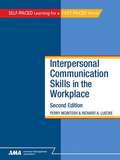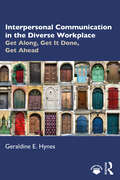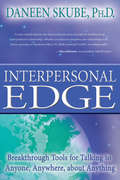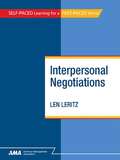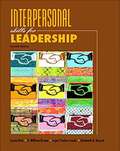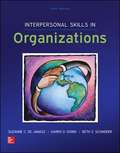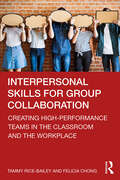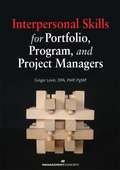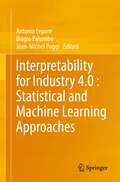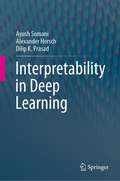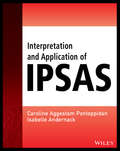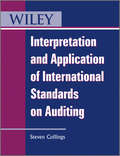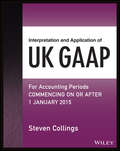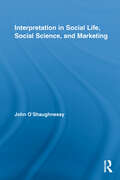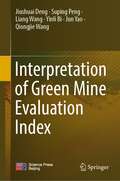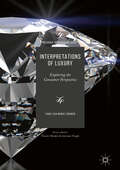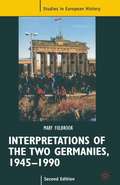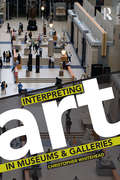- Table View
- List View
Internships in Psychology: The APAGS Workbook for Writing Successful Applications and Finding the Right Fit
by Carol Williams-Nickelson PsyD Dr. Mitch Prinstein PhD Dr. W. Greg Keilin PhDThis authoritative, hands‑on book provides doctoral‑level psychology students with all the resources they need to successfully navigate the internship application process. Topics include the most common reasons why people don&’t secure a position; how many sites to apply to; rank ordering your list of programs; writing essays, cover letters, and your curriculum vitae; securing strong letters of recommendation; preparing for interviews; sending thank you notes; receiving Match results; and more. Since the third edition of this book was released, the online application process and the internship marketplace have undergone significant changes, such as the growing importance of accreditation. This fourth edition provides updated information that will help your applications stand out to your internship programs of choice. Advice is also offered to directors of clinical training so they can guide and support students during this challenging process. This resource is provided to students by the American Psychological Association of Graduate Students—the premier group committed to representing, leading, advocating, and developing resources for graduate psychology students.
Internships in Sport Management
by Matthew Walker Robin Ammon Edward E. Seagle Ralph W. SmithIn this book "Internships in Sport Management", students will be introduced to the concept of a "game plan for success" and provided with application exercises to help develop their own personalized plan. This cutting edge how-to-do-it manual is chock-full of real-life examples presented by previous sport management students from across the country. The authors furnish the reader with important ideas for creating an eye-opening cover letter, strategies necessary for a powerful resume, and other indispensable suggestions. The reader will develop a professional attitude and attention to detail that will ensure that the interviewee makes a positive first impression. This textbook is the ultimate tool to prepare a sport management student for that crucial internship in sport event management, intercollegiate athletics, minor league sport, sport facility management, sport marketing, sport/business and sport/entertainment industries.
Interop: The Promise and Perils of Highly Interconnected Systems
by John Palfrey Urs GasserIn Interop, technology experts John Palfrey and Urs Gasser explore the immense importance of interoperability-the standardization and integration of technology-and show how this simple principle will hold the key to our success in the coming decades and beyond. The practice of standardization has been facilitating innovation and economic growth for centuries. The standardization of the railroad gauge revolutionized the flow of commodities, the standardization of money revolutionized debt markets and simplified trade, and the standardization of credit networks has allowed for the purchase of goods using money deposited in a bank half a world away. These advancements did not eradicate the different systems they affected; instead, each system has been transformed so that it can interoperate with systems all over the world, while still preserving local diversity. As Palfrey and Gasser show, interoperability is a critical aspect of any successful system-and now it is more important than ever. Today we are confronted with challenges that affect us on a global scale: the financial crisis, the quest for sustainable energy, and the need to reform health care systems and improve global disaster response systems. The successful flow of information across systems is crucial if we are to solve these problems, but we must also learn to manage the vast degree of interconnection inherent in each system involved. Interoperability offers a number of solutions to these global challenges, but Palfrey and Gasser also consider its potential negative effects, especially with respect to privacy, security, and co-dependence of states; indeed, interoperability has already sparked debates about document data formats, digital music, and how to create successful yet safe cloud computing. Interop demonstrates that, in order to get the most out of interoperability while minimizing its risks, we will need to fundamentally revisit our understanding of how it works, and how it can allow for improvements in each of its constituent parts. In Interop, Palfrey and Gasser argue that there needs to be a nuanced, stable theory of interoperability-one that still generates efficiencies, but which also ensures a sustainable mode of interconnection. Pointing the way forward for the new information economy, Interop provides valuable insights into how technological integration and innovation can flourish in the twenty-first century.
Interoperabilität im Detail verstehen: Hands-on Healthcare & Interoperability (essentials)
by Frank Oemig Viola Henke Marcus KuperDieses essential bietet einen Einstieg in die Fragestellung, was mit dem Begriff „Interoperabilität“ gemeint ist, der nicht nur den Datenaustausch zwischen IT-Systemen im Gesundheitswesen beschreibt. Dazu werden die in diesem Kontext häufig gebrauchten Begriffe wie Kompatibilität oder Konformität erläutert und in einen Zusammenhang gebracht. Weiterhin wird aufgezeigt, dass Interoperabilität das Ergebnis eines längeren Arbeits- und Austauschprozesses ist und wie „Interoperabilität“ für den erfolgreichen und reibungslosen Einsatz im Gesundheitssystem gemeinsam mit allen Stakeholdern weiterentwickelt werden kann.
Interorganisationale kollaborative Gemeinschaftsforschung: Forschungscampus für den Automobilbau der Zukunft: ARENA2036 (ARENA2036)
by Roeland HoogeveenWie verhalten sich Spitzenkräfte aus Universität, Forschungseinrichtungen und Industrie unter einem Dach? Wie entstehen Ideen, was fördert die Kreativität, wie bringt man die Ergebnisse schnell aus der Forschungsfabrik in die industrielle Produktion? Diese und angrenzende Fragen werden in diesem Forschungsbericht beantwortet.Im Querschnittsbereich der ARENA2036 wurde die spezielle Arbeitsumgebung – die Forschungsfabrik – arbeitswissenschaftlich fundiert ausgestaltet. In diesem Buch werden die resultierenden Analysen und Reflexion vorgestellt. Ferner werden Methoden dargestellt, um die Technologie- und Produktentwicklung besser aufeinander abzustimmen. Ergebnisse zur interdisziplinäre Zusammenarbeit innerhalb der ARENA2036 werden diskutiert und daraus ein Ansatz zur beschleunigten Verbreitung der benötigten Kompetenzen entwickelt, die zur Nutzung grundlegend neuer Technologien benötigt werden.
Interorganizational Decision Making
by Tuite Matthew Chisholm Roger Radnor MichaelAs organizations have grown in scale and scope of activities, so have social pressures on every aspect of organizational activity from personnel policies to waste disposal practices. This volume is a rare example of a multidisciplinary approach to an important theoretical problem--the proper means of interorganizational decision making in light of these new pressures. This complex subject is here attacked by nineteen prominent behavioral scientists from a variety of disciplines.The study of interorganizational decision-making is aimed at moving game situations from conditions of conflict or mixed conflict-cooperation to conditions of pure cooperation. It seeks means of facilitating the coordination of decisions whenever interdependencies exist between the decision units. The book discusses variables, which may affect decision making, including awareness of individual and collective payoffs, choice of an organizational structure, response of boundary personnel, and the decision technology that exists to guide the decision makers.The book contains studies on all interorganizational decision making situations, including individual and joint decisions, those at the interface of government and business, and decision making at the international level. Contributions are balanced between quantitative building approaches and practical empirical applications, suggesting avenues for both theoretical and practical work in this new field. The book will be of profound interest to all behavioral and management scientists.
Interpersonal Communication Skills in the Workplace, Second Edition
by Perry Mcintosh Richard Luecke Jeffery H. DavisEffective communication is an important element of success for every organization, leader, manager, supervisor, and employee. Good communication skills are a prerequisite for advancement in most fields and are key to exercising influence both within and beyond the work group. This edition retains the subject matter strengths of the previous version and augments them with content that reflects new understandings of interpersonal communications, new communication technologies, and new organizational practices that include wider spans of management control, greater employee empowerment, geographically dispersed work groups, and team-based activities. It also contains new material on persuasive communications, dialogue, and nominal group technique. New chapters on techniques for generating ideas and solutions and communicating in the multicultural workplace offer fresh perspectives on topics that have become increasingly important in today’s workplace. Throughout the book, the authors provide assessments, exercises, and Think About It sections that offer readers numerous opportunities for practice and feedback. Any person can realize the benefits of improved communication skills. Interpersonal Communication Skills in the Workplace, Second Edition, provides the insight and expertise needed to achieve this goal. Readers will learn how to: * Solve common communication problems. * Communicate with different personality types. * Read non-verbal cues. * Improve listening skills. * Give effective feedback. * Be sensitive to cultural differences in communication.
Interpersonal Communication in the Diverse Workplace: Get Along, Get It Done, Get Ahead
by Geraldine HynesForegrounding the vital importance of interpersonal communication and cultural competence in the workplace, this book offers concise, practical strategies for daily communication in a global business environment. The workplace is steadily becoming more diverse, and cultural competence is widely recognized as a key to success, in terms of revenue, profit, market share, and workforce productivity. This and diversity appreciation are the two cornerstones for effective interpersonal communication, facilitating relationship development, improving job satisfaction, commitment, loyalty, and trust, and leading to performance and organizational success. The effectiveness of diversity training sessions and cultural guidebooks can vary – business professionals need a book that presents more than descriptions of culture-bound business practices or prescriptions for valuing diversity. This book is that practical solution, presenting a conceptual model along with tools to put it to work from day one, including cases and examples. With its strategies for reducing diversity miscues, techniques for responding in uncomfortable conversations, and innovative ways to bridge cultural gaps, this book will help current and aspiring leaders across industries build rapport and promote constructive behaviors in a diverse work environment, resulting in organizational success.
Interpersonal Edge: Breakthrough Tools For Talking To Anyone, Anywhere, About Anything
by Daneen SkubeUp till now, the cutting-edge tools in this book have only been available to management teams, high-level executives, and select clients. You’ve no doubt picked it up because you want to be the CEO of your own life—with a greater sense of empowerment and confidence. <P><P>Written by Daneen Skube, syndicated columnist, sought-after executive coach, and innovative therapist, this practical and humorous work provides simple tools you can use today to gain respect, get immediate results, and turn the lemons of life into big opportunities. Readers of Daneen’s wildly popular column have been clamoring for a decade for a book of this kind, which offers an in-depth look at her advice and methods. <P><P>Whether you’re dealing with a backstabbing co-worker, trying to get a promotion, or want to rekindle a romance, you’ll do it all better with an interpersonal edge. In all situations, you’ll have in your possession reliable tools to make almost anything you want to happen.The keys to the life you’ve longed for are within these pages—just add you and stir.
Interpersonal Negotiations Breaking Down the Barriers
by Len LeritzFinally…a negotiation framework that encourages a positive outcome for both parties. This book takes the "win/win" concept a step further to make negotiating a more gratifying experience—even if you don’t get exactly what you want. Interpersonal Negotiations: Breaking Down the Barriers builds on mutual understanding and respect for each other's needs and provides a proven framework for fulfilling them. You’ll discover the secrets that can help turn an adversary into an advocate. You will learn how to: • Ensure a safe, fair, and effective negotiation process • Direct the negotiation process to create mutual understanding and acceptance • Recognize and understand your own needs and those of the other person • Make it easy for others to understand your needs • Be creative and persistent to address and resolve blocks to successful negotiation • Assess the other person's behavioral and emotional responses • Acknowledge your own and the other person's perceptions and beliefs • Avoid getting mired in the process
Interpersonal Skills For Leadership
by William Brown Susan Fritz Joyce Lunde Elizabeth BansetFor courses in interpersonal skills, communication, leadership development, or service learning in Business Studies departments. This practical resource provides an introduction to interpersonal skills theories which are reinforced through experiential activities. Coverage focuses on the development of the basic interpersonal skills necessary to command one's own life, relate well to other people and to lead others in positive directions.
Interpersonal Skills In Organizations (Fifth Edition)
by Suzanne C. De Janasz Karen O. Dowd Beth Z. SchneiderInterpersonal Skills in Organizations by de Janasz, Dowd, and Schneider takes a fresh, thoughtful look at the key skills necessary for personal and managerial success in organizations today. Exploding with exercises, cases, and group activities, the book employs an experiential approach suitable for all student audiences. The book is organized into 4 distinct sections (Understanding Yourself, Understanding Others, Understanding Teams, and Leading) that can be used collectively or modularly depending on the instructors' preferences and students' needs. The emphasis in this edition focuses on making the text more current along with making the text pedagogically effective for students and instructors.
Interpersonal Skills for Group Collaboration: Creating High-Performance Teams in the Classroom and the Workplace
by Tammy Rice-Bailey Felicia ChongThis lively and engaging text introduces readers to the core interpersonal and organizational skills needed to effectively collaborate on group projects in the classroom and the workplace. Group projects are critical in preparing students for the realities of today’s workplace, but many college students despise group work—often because they have not been prepared with the necessary skills to effectively collaborate. This guide teaches core collaboration skills such as active listening, interviewing, empathy, and conflict resolution. It examines the research and theory behind these skills, and provides tangible ways to practice these skills both alone and in groups. This guide can be used a supplementary text for any courses involving group projects, and will also be of interest to professionals in communication, business, and many other fields.
Interpersonal Skills for Portfolio, Program, and Project Managers
by Ginger Levin DPA, PMP, PgMPImprove Your Interpersonal Skills to Achieve Greater Management Success!Any formula for management success must include a high level of interpersonal skills. The growing complexity of organizational portfolios, programs, and projects, as well as the increasing number and geographic dispersion of stakeholders and employees, makes a manager's interpersonal skills critical. The frequency and variety of interpersonal interactions and the pressure to perform multiple leadership roles successfully while ensuring customer satisfaction have never been greater.Interpersonal Skills for Portfolio, Program, and Project Managers offers practical and proven tools and methods you can use to develop your interpersonal skills and meet the challenges of today's competitive professional environment.Develop the interpersonal skills you need to:• Build effective, high-performing teams• Work efficiently with virtual teams• Develop approaches to build and maintain relationships with stakeholders at all levels• Handle stress and deal with unexpected critical incidents• Motivate your teamWhatever your level of experience, you will find these practical and proven methods to be the best formula for improving your interpersonal skills-and enhancing your management success.The chapters include discussion questions, making this a perfect text for use in academic or workshop settings.
Interpretability for Industry 4.0 : Statistical and Machine Learning Approaches
by Jean-Michel Poggi Antonio Lepore Biagio PalumboThis volume provides readers with a compact, stimulating and multifaceted introduction to interpretability, a key issue for developing insightful statistical and machine learning approaches as well as for communicating modelling results in business and industry.Different views in the context of Industry 4.0 are offered in connection with the concepts of explainability of machine learning tools, generalizability of model outputs and sensitivity analysis. Moreover, the book explores the integration of Artificial Intelligence and robust analysis of variance for big data mining and monitoring in Additive Manufacturing, and sheds new light on interpretability via random forests and flexible generalized additive models together with related software resources and real-world examples.
Interpretability in Deep Learning
by Alexander Horsch Ayush Somani Dilip K. PrasadThis book is a comprehensive curation, exposition and illustrative discussion of recent research tools for interpretability of deep learning models, with a focus on neural network architectures. In addition, it includes several case studies from application-oriented articles in the fields of computer vision, optics and machine learning related topic. The book can be used as a monograph on interpretability in deep learning covering the most recent topics as well as a textbook for graduate students. Scientists with research, development and application responsibilities benefit from its systematic exposition.
Interpretation and Application of IPSAS
by Caroline Aggestam-Pontoppidanin places where IFRS has none. This book provides complete guidance to IPSAS, with clear explanation and expert insight.Understand the meaning and role of each standardApply the standards to real-world scenariosManage the process of transition to IPSASThese standards are meant to be followed by all public sector entities, including national and regional governments and local authorities. They've been adopted by the UN, NATO, the European Commission, and others, and either have been or soon will be adopted in Malaysia, Switzerland, Spain, and more.
Interpretation and Application of International Standards on Auditing
by Steven CollingsWritten by Steven Collings, winner of Accounting Technician of the Year at the British Accountancy Awards 2011, this book deals with the significant changes auditing has undergone in recent years, due in large part to well-publicised corporate disasters such as Enron and Parmalat, which have shaken the profession. In response, many countries have replaced pre-existing domestic standards with International Standards on Auditing (ISAs) in an attempt to ensure that auditors throughout the world apply the same level of standards during all audit assignments, and that audit quality remains consistent on a global basis.International Standards on Auditing are frequently updated to improve and clarify their application throughout the audit and accounting profession. They can be extremely complex and difficult to apply in real life situations. It is essential to apply the standards with sufficient rigor to enable an efficient audit to take place, to satisfy the regulators and ensure that the client receives and audit which is beneficial, cost effective, and which conforms to the prescribed framework; however, auditors are often criticised for failing to do so.Recognising that auditing is not always an exact science, and that in many cases the auditor is called upon to make a judgement in situations open to differing opinions, this book takes a practical and pragmatic approach to following International Standards on Auditing. Steve Collings looks at the full ISAs in their final form, as reissued following the IAASB 'Clarity Project', and give auditors guidance on how to interpret and apply them in real life situations. Each redrafted or rewritten ISA is dealt with in a separate chapter, containing case studies and illustrative examples. The book also covers the regulatory framework of auditing and gives a summary of the five ethical standards applicable to auditors, as mapped by the IAASB. Detailed appendices provide an overview of IFRS and IAS, illustrative audit tests and illustrative financial statements.
Interpretation and Application of UK GAAP: For Accounting Periods Commencing On or After 1 January 2015 (Wiley Regulatory Reporting)
by Steven CollingsGet up to date on the latest UK GAAP, with practical application guidance Interpretation and Application of UK GAAP is a comprehensive, practical guide to applying UK GAAP at all levels, for accounting periods commencing on or after January 1, 2015. This book examines all of the core principles for every business, from subsidiaries of major listed companies right down to the very small, owner-managed business. Each chapter includes a list of relevant disclosure requirements to facilitate understanding, and real-world examples bring theory to life to provide guidance toward everyday application. Readers gain practical insight into the preparation of accounts under the EU-adopted IFRS, FRSs 100, 101, and 102, the FRSSE, and the Companies Act 2006, with expert guidance as to which requirements apply in which situations, and to which companies, and the type of disclosure each scenario requires. The book also includes detailed analysis of the planned changes to the Small Companies' Regime which are scheduled to take effect in 2016. With sweeping changes coming into effect from January 1st 2015, financial statement preparers must have a sound appreciation of how the new UK GAAP works. This book provides a complete guide, with the latest regulations and straightforward advice on usage. Understand UK GAAP application at all levels Learn how to handle all relevant key accounting treatments Refer to complete disclosure requirement lists for each topic Get up to date on the latest area-specific practices With new accounting practices in many broad areas including investment property, inventory valuations, deferred tax, fixed assets, and more, auditors and accountants need an awareness of how the new financial reporting regime will affect them. Interpretation and Application of UK GAAP is the most comprehensive reference, with the latest information and practical guidance.
Interpretation in Social Life, Social Science, and Marketing (Routledge Interpretive Marketing Research)
by John O'Shaughnessy'Interpretation' is used as an umbrella for bringing together a wide range of concepts and developments in the philosophy of social science that provide the foundation for clear thinking about social phenomena. In his new book, John O’Shaughnessy familiarises the reader with the nature of interpretation and its importance in social life, decision making in social science enquiries and consumer marketing, thus offering a multidisciplinary approach to problems of bias and uncertainty. Thus, this book is novel in its outlook and comprehensive in its approach. Whereas past studies in interpretation have focused on hermeneutical methods, O’Shaughnessy goes further considering the role of interpretation in social interactions, in undertaking scientific work, in the use of statistics, in causal analysis, in consumer evaluations of products and artifacts and in interpreting problematic situations together with the corresponding biases arising from emotional happiness and the concepts employed.
Interpretation of Elasticity Calculations
by Pai-Ling YinExplains when to apply the conventional and midpoint elasticity theorems and how to interpret the results.
Interpretation of Green Mine Evaluation Index
by Liang Wang Jun Yao Suping Peng Jiushuai Deng Yinli Bi Qiongjie WangThis book focuses on green mine evaluation. It includes green mine evaluation methods, evaluation content, evaluation indicators, etc. The "Green Mine Evaluation Index" has been issued by the Ministry of Natural Resources of China. In order to promote mining enterprises, green mine consulting service agencies, third-party evaluation agencies and mining administration personnel to better understand and practice the provisions of green mine evaluation indicators, the authors wrote this "Interpretation of Green Mine Evaluation Index". The content of this book specifically includes introduction, prerequisites for green mine selection, score sheet of green mine construction, related knowledge, as well as introduction of specific green mine evaluation items, including mining area environment, resource development methods, comprehensive utilization of ore resources, energy saving and emission reduction, technological innovation and smart mines, corporate management and corporate image, etc. The relevant concepts, relevant laws and policies, implementation measures, inspection points, and materials that enterprises should provide, have been vividly expounded based on the actual situation and specific cases of green mine construction. This book is useful as a reference for managers, engineering and technical personnels, teachers and students from mining enterprises, government departments, consulting services and evaluation agencies, colleges and secondary professional schools.
Interpretations of Luxury
by Linda Lisa Maria TurunenExploring the elements that constitute the perceived luxuriousness of a brand, this book addresses the changing definitions of the term 'luxury' in today's world. Taking the approach that the concept of luxury evolves from the consumer, the author introduces a conceptual model which explains how the consumer interprets the luxuriousness of a brand. This innovative study analyses the key elements that influence luxury branding, such as extended product, perceived uniqueness, authenticity and context specificity. By critically reflecting on the existing definitions of luxury and its challenges, this book makes a unique contribution to research and an essential read for marketing students and scholars.
Interpretations of the Two Germanies
by Mary FulbrookThe two Germanies, arising from the unpromising ashes of defeated Nazi Germany, came to represent opposing models of state and society. The Federal Republic established itself as a remarkably stable democracy and successful social market economy: the German Democratic Republic developed an apparently exemplary form of 'actually existing socialism' and became a pillar of the Soviet bloc. Then in 1989, the 'gentle revolution' in East Germany added a new twist with the collapse of Communist rule. With rapid reunification, the united Germany of 1990 faced new challenges as the unprecedented transformation created a multitude of economic problems and social tensions. Previously published in 1992 as The Two Germanies, this book has been fully revised and updated to take account of all the latest developments in contemporary German history.
Interpreting Art in Museums and Galleries
by Christopher WhiteheadIn this pioneering book, Christopher Whitehead provides an overview and critique of art interpretation practices in museums and galleries. Covering the philosophy and sociology of art, traditions in art history and art display, the psychology of the aesthetic experience and ideas about learning and communication, Whitehead advances major theoretical frameworks for understanding interpretation from curators’ and visitors’ perspectives. Although not a manual, the book is deeply practical. It presents extensively researched European and North American case studies involving interviews with professionals engaged in significant cutting-edge interpretation projects. Finally, it sets out the ethical and political responsibilities of institutions and professionals engaged in art interpretation. Exploring the theoretical and practical dimensions of art interpretation in accessible language, this book covers: The construction of art by museums and galleries, in the form of collections, displays, exhibition and discourse; The historical and political dimensions of art interpretation; The functioning of narrative, categories and chronologies in art displays; Practices, discourses and problems surrounding the interpretation of historical and contemporary art; Visitor experiences and questions of authorship and accessibility; The role of exhibition texts, new interpretive technologies and live interpretation in art museum and gallery contexts. Thoroughly researched with immediately practical applications, Interpreting Art in Museums and Galleries will inform the practices of art curators and those studying the subject.
